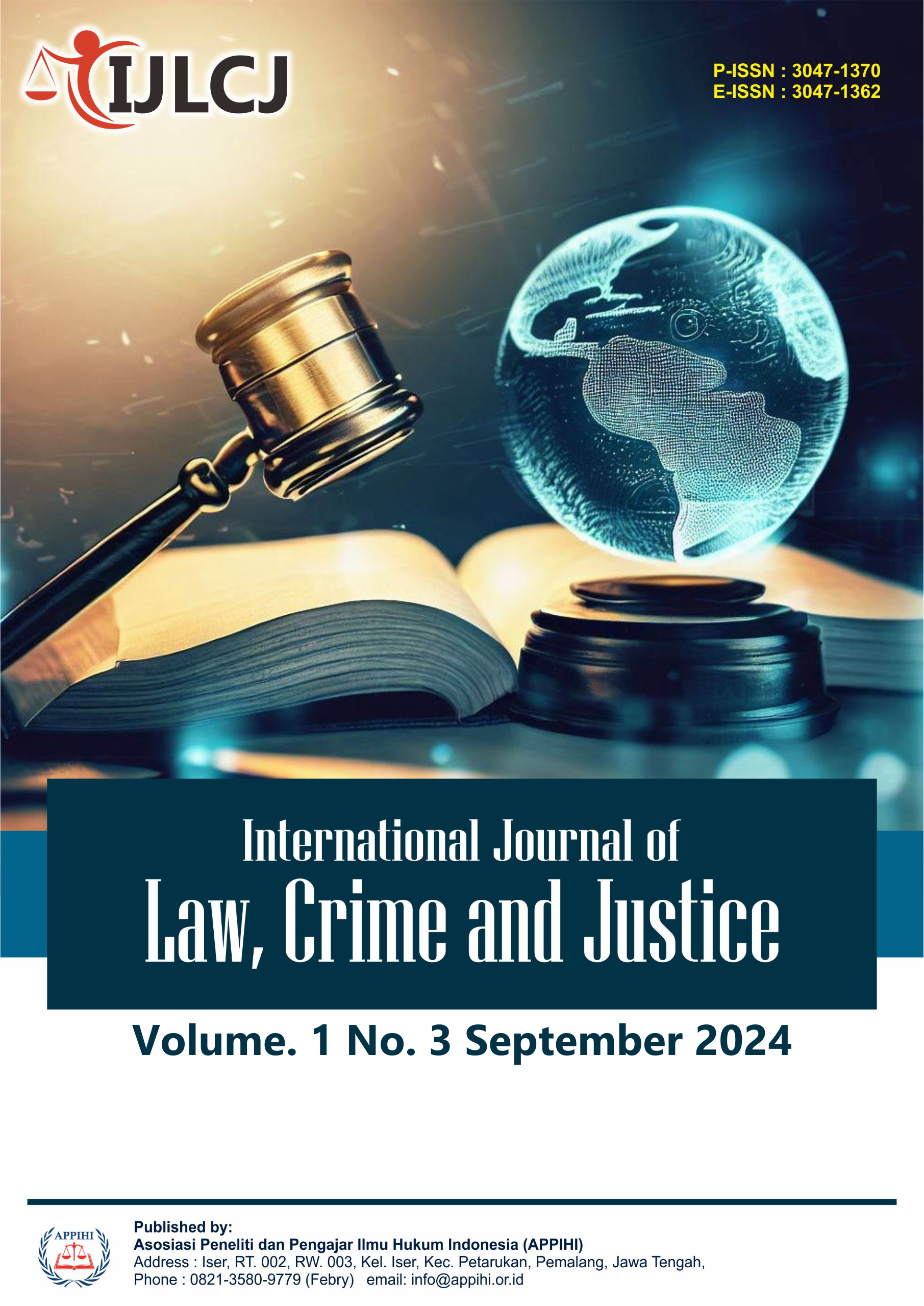Analysis of The Effectiveness of Visum Et Repertum Examination on Unidentified Corpses in the Criminal Investigation Process
Research Study at Bhayangkara Batam Hospital, Riau Islands Police
DOI:
https://doi.org/10.62951/ijlcj.v1i3.141Keywords:
Effectiveness, Visum Et Repertum, Corpses Without Identity, InvestigationAbstract
The background of this research is the importance of the Visum et Repertum (VeR) examination in identifying victims and determining the cause of death, especially in cases of unidentified corpses that are often found in the Riau Islands area. Proper and accurate VeR checks are vital to support the criminal investigation process, provide justice for victims and their families, and maintain the integrity of the criminal justice system. The purpose of this study is to analyze the effectiveness of the VeR examination conducted at Bhayangkara Batam Hospital in assisting victim identification and supporting criminal investigations. The study also aims to identify the obstacles faced in the examination process and provide suggestions to improve its effectiveness. The purpose of this study is to analyze the effectiveness of the VeR examination conducted at Bhayangkara Batam Hospital in assisting victim identification and supporting criminal investigations. The study also aims to identify the obstacles faced in the examination process and provide suggestions to improve its effectiveness. The research method used is normative juridical with an empirical juridical approach at Bhayangkara Batam Hospital. The data was collected through in-depth interviews with forensic doctors, police investigators, and analysis of VeR documents and reports. The data obtained were analyzed using positive law theory from John Austin, legal system theory from Lawrence M. Friedman, and evidentiary law theory. The results showed that although the VeR examination at Bhayangkara Batam Hospital was generally effective, although there were several obstacles that affected the quality and speed of the examination, such as limited resources, medical personnel skills, and the condition of the corpses that were often decomposed. Suggested efforts to overcome these obstacles include improving forensic medical facilities and equipment, ongoing training for medical personnel, implementing standard protocols, and increasing cooperation between related agencies. Suggestions include the need for governments to invest more in forensic infrastructure, the importance of public education on missing persons reporting, and the need for increased collaboration and integrated training for investigators and forensic experts. With the implementation of these suggestions, it is hoped that the effectiveness of VeR examinations can be improved, thereby supporting criminal investigations in a more efficient and fair manner.
Downloads
References
Ali, A. (2012). Menguak teori hukum (Legal Theory) dan teori peradilan (Judicialprudence). Kencana Prenada Group.
Ali, A., & Heryani, W. (2013). Asas-asas hukum pembuktian perdata. Kencana Prenadamedia Group.
Anonymous. (2023). Buku pedoman penyusunan proposal dan tesis program magister ilmu hukum pascasarjana (S2). Universitas Batam.
Arikunto, S. (2010). Prosedur penelitian: Suatu pendekatan praktik. Rineka Cipta.
Aritafika, R. (2019). Efektivitas tindakan otopsi terhadap tindak pidana pembunuhan pada tingkat penyidikan. Fakultas Hukum Universitas Sriwijaya.
Dimyati, K. (2015). Teorisasi hukum: Studi tentang perkembangan pemikiran hukum di Indonesia 1945-1990. Muhamadiyah University Press.
Erniyanti, & Syahputra, R. (2024). Fungsi yuridis lembaga kemasyarakatan di daerah. Gita Lentera.
Friedman, L. M. (2009). Sistem hukum dalam perspektif ilmu sosial: The legal system: A social science perspective. Nusa Media.
Friedman, W. (2010). Teori dan filsafat hukum: Telaah kritis atas teori-teori hukum (susunan I). Rajawali (diterjemahkan dari buku aslinya "Legal Theory" oleh Mohamad Arifin).
Fuady, M. (2013). Teori-teori besar (grand theory) dalam hukum. Kencana.
Gumilang, A. (2013). Kriminalistik: Pengetahuan tentang teknik dan teknik penyidikan. Angkasa.
Harahap, M. Y. (2016). Pembahasan permasalahan dan penerapan KUHAP: Pemeriksaan sidang pengadilan, banding, kasasi, dan peninjauan kembali (Edisi ke-2, Cet. 8). Sinar Grafika.
Haryanto, S. (2012). Spektrum teori sosial. Ar-Ruzz Media.
Huijbers, T. (2011). Filsafat hukum. Kanisius.
Ilyas, A. (2012). Asas-asas hukum pidana. Mahakarya Rangkang.
Lingga, C. D. (2022). Mekanisme visum et repertum terhadap mayat tanpa identitas oleh tim dokter forensik untuk kepentingan penyidikan menurut perspektif hukum pidana Islam (Studi kasus di Rumah Sakit Bhayangkara TK III Palembang dalam hal penemuan mayat di perairan). Fakultas Hukum Universitas Islam Negeri (UIN) Raden Fatah.
Mamudji, S. (2015). Penelitian hukum normatif: Suatu tinjauan singkat. Raja Grafindo Persada.
Muhajir, N. (2010). Metodologi penelitian kualitatif. Roke Sarasin.
Muniati, K. D. (2023). Efektivitas visum et repertum pada proses penyidikan dalam tindak pidana pembunuhan berencana (Studi putusan Nomor: 214/Pid.B/2019/PN.BNA). Fakultas Hukum Universitas Islam Negeri Ar-Raniry.
Prastowo, A. (2011). Memahami metode-metode penelitian: Suatu tinjauan teoristis dan praksis. Ar-Ruzz Media.
Punto, R. (2014). Konsep efektivitas. Jurnal yang dipublikasikan, Universitas Negeri Yogyakarta.
Rahardjo, S. (2016). Ilmu hukum. Citra Aditya Bakti.
Ranoemihardja, R. A. (2014). Ilmu kedokteran kehakiman forensic science (Ed. 2). Tarsito.
Rasyidi, L. (2006). Dasar-dasar filsafat hukum. Citra Aditya Bakti.
Respationo, S. (2020). Urgensi prolegda dalam penetapan kebijakan pemerintahan daerah. Mustika Khatulistiwa.
Sidharta, A. B., & Meuwissen, T. (2016). Pengembangan hukum, ilmu hukum, teori hukum dan filsafat hukum. Refika Aditama.
Singarimbun, M., & Effendi, S. (2009). Metode penelitian survei. LP3ES.
Soekanto, S., & Mamudji, S. (2003). Penelitian hukum normatif: Suatu tinjauan singkat (Cetakan Ketujuh). Raja Grafindo Persada.
Soemitro, R. H. (2015). Metodologi penelitian hukum (Cetakan Kedua). Ghalia Indonesia.
Soeparmono, R. (2012). Keterangan ahli dan visum et repertum dalam aspek hukum acara pidana. Mandar Maju.
Soeryasumantri, J. S. (2008). Filsafat ilmu: Sebuah pengantar populer. Sinar Harapan.
Soesilo, R. (2009). Kriminalistik: Ilmu penyidikan kejahatan. Politeia.
Sugono, B. (2001). Metoda penelitian hukum. Raja Grafindo Persada.
Suhartono, I. (2009). Metode penelitian sosial: Suatu teknik penelitian bidang kesejahteraan sosial dan lainnya. Remaja Rosda Karya.
Undang-Undang Dasar Negara Republik Indonesia Tahun 1945.
Undang-Undang Republik Indonesia Nomor 1 Tahun 1946 tentang Kitab Undang-undang Hukum Pidana (KUHP).
Undang-Undang Republik Indonesia Nomor 8 Tahun 1981 tentang Kitab Undang-undang Hukum Acara Pidana (KUHAP).
Yusuf, C. F. (2008). Efektivitas pokjawas dan kinerja pengawas pendidikan agama Islam. Cena Citasatria.
Downloads
Published
How to Cite
Issue
Section
License
Copyright (c) 2024 International Journal of Law, Crime and Justice

This work is licensed under a Creative Commons Attribution-ShareAlike 4.0 International License.





